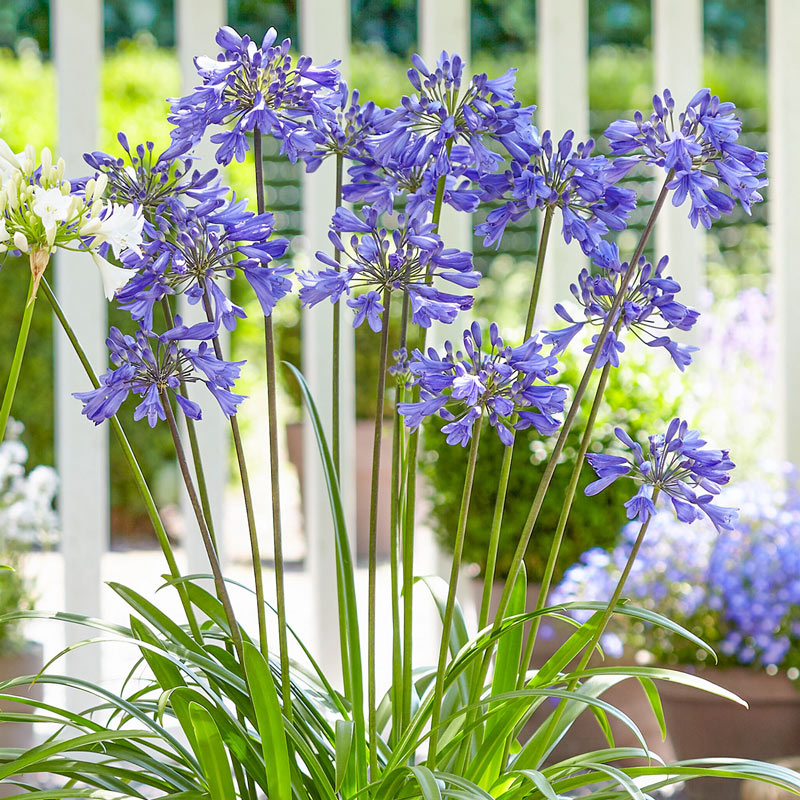Typical Agapanthus Problems and How to Address Them
Typical Agapanthus Problems and How to Address Them
Blog Article
Understanding the Art of Agapanthus Treatment: Vital Steps for Healthy Development and Dynamic Blossoms
In the world of gardening, the growing of agapanthus stands as a rewarding undertaking for those that look for to nurture these elegant blooming plants. From choosing the right variety to mastering trimming strategies, the trip towards cultivating growing agapanthus plants is diverse and holds the key to opening the complete possibility of these agricultural treasures.

Selecting the Right Agapanthus Range

When selecting the best Agapanthus range for your yard, think about variables such as climate viability, flower color, and development habit. Agapanthus, generally called Lily of the Nile or African lily, is available in a selection of colors varying from tones of blue and purple to white. Choose a bloom color that enhances your existing yard scheme to produce a harmonious landscape. Additionally, take into consideration the environment in your region to ensure the Agapanthus variety you select can thrive in your certain conditions. Some varieties are much more tolerant of cool temperatures, while others favor warmer environments. Understanding the growth habit of different Agapanthus ranges is critical for correct positioning within your yard. Some ranges have a clumping development habit, suitable for containers or boundaries, while others have a more dispersing nature, appropriate for ground cover or mass plantings. By very carefully assessing these elements, you can pick the excellent Agapanthus range to boost the beauty of your garden.
Perfect Planting Problems
Considering the ideal ecological requirements is essential for successful Agapanthus farming. Agapanthus plants are delicate to chilly temperature levels and need to be safeguarded from frost during winter months.
To guarantee healthy and balanced development and lively flowers, plant Agapanthus bulbs at a depth of about 2-4 inches and room them 8-12 inches apart. Mulching around the base of the plants helps maintain dampness and reduces weed development.
Watering and Feeding Tips
Maintaining appropriate wetness degrees and providing crucial nutrients are crucial elements in the treatment routine for Agapanthus plants. When it comes to sprinkling Agapanthus, it is essential to strike a balance. These plants favor constantly moist soil yet are at risk to root rot if overwatered.
Feeding Agapanthus is essential for promoting healthy and balanced development and prolific blossoms. Apply a balanced plant food, such as a 10-10-10 formula, in the very early spring as brand-new development arises. Repeat this application every 6-8 weeks throughout the expanding season. Stay clear of too much fertilizing, as it can bring about rich foliage at the cost of blooms. Constantly adhere to the manufacturer's directions for proper dilution and application methods. By following these watering and feeding ideas, you can my link ensure your Agapanthus plants grow and generate dynamic, lasting blossoms.
Pruning Strategies for Agapanthus
Trimming Agapanthus plants at the ideal times and with correct techniques is critical for keeping their health and promoting optimum growth and blooming. The optimal time to trim Agapanthus is in late winter season or very early spring prior to brand-new growth arises.
Deadheading spent flowers can also reroute the plant's power into creating even more blooms rather than setting seeds. If you want to collect seeds for proliferation, leave some flowers to completely dry and mature on the plant.
Remember to utilize tidy, sharp devices to make specific cuts and minimize the threat of introducing illness. Agapanthus. Regular pruning will certainly help keep your Agapanthus looking neat and healthy and balanced while ensuring a plentiful screen of lovely blooms
Handling Common Parasites and Illness
After guaranteeing correct trimming techniques for Agapanthus, it is vital to attend to usual bugs and conditions that can affect the wellness and vigor of these plants. One usual bug that impacts Agapanthus is the Agapanthus gall midget.
In addition, Agapanthus plants can endure from origin rot if they are planted in badly draining soil. By being alert and taking punctual action versus parasites and conditions, you can help your Agapanthus plants flourish and generate vivid blossoms. Agapanthus.

Conclusion
In conclusion, grasping the art of agapanthus treatment entails picking the right selection, providing perfect planting problems, correct watering and fertilizing, proper pruning techniques, and addressing typical pests see page and diseases. By following these crucial actions, you can guarantee healthy development and lively blossoms for your agapanthus plants. Remember to frequently keep track of and keep your plants to advertise their total health and longevity.
To ensure healthy and balanced growth and dynamic blossoms, plant Agapanthus bulbs at a deepness of about 2-4 inches and area them 8-12 inches apart. By following these watering and feeding ideas, you can ensure your Agapanthus Agapanthus plants grow and produce lively, durable blooms.
One common parasite that influences Agapanthus is the Agapanthus gall midget. In addition, Agapanthus plants can experience from root rot if they are grown in inadequately draining pipes dirt. By complying with these vital steps, you can make certain healthy and balanced growth and vibrant flowers for your agapanthus plants.
Report this page